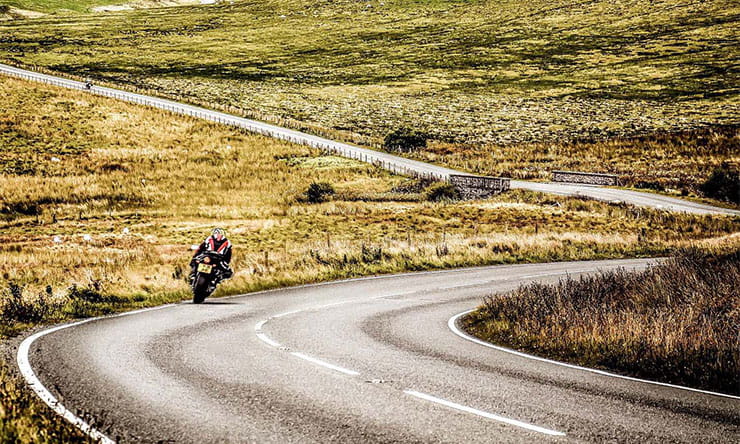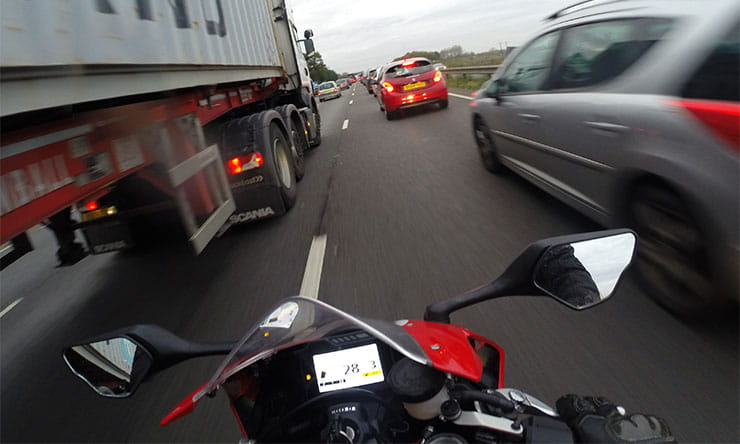Here, ladies and gentlemen, is the condensed wisdom of six hugely experienced police motorcyclists, one crash investigator and two professional road testers. By its nature, this list is a skim – you won’t become a better rider just by reading it – but hopefully it’ll give you some ideas to practice. And that’s when the big improvements happen.
1. Look further
The number one way to improve your riding is to look as far ahead as is physically possible. Even experienced riders often don’t do this, and find themselves reacting to hazards rather than planning for them. It takes practice though, because our instinct is to check what’s right in front of us. Keep telling yourself ‘eyes up’ and use your peripheral vision to keep tabs on the near stuff.

This is linked to #1, and involves looking for the point where the two edges of the road converge when cornering. If that point appears to be moving towards you, the corner is tightening, so slow down. If it doesn’t appear to move, you’re at the right speed. And if it’s moving away, the corner is opening up and you can think about getting on the throttle. Remember this technique is only one tool – over-reliance can cause you to miss other vital clues.
3. Make plans
Seeing hazards miles ahead isn’t much use if you don’t interpret them and decide what to do. You need to have a plan that constantly evolves as you get more information. It’s worth spending five minutes of every ride practicing the ‘so what?’ test. Ask yourself ‘so what?’ when you see stuff in the distance. It could go like this: you see a junction warning sign before a corner – so what?. There might be a car poking its nose out as I exit the corner – so what? I’d better adjust my line and be prepared to brake.
4. Relax
Upper body tension wrecks a bike’s handling because it stops the bars moving freely. If you find the bike doesn’t want to turn, or keeps running wide, check your upper body for tension. Aching neck or shoulders are a clue. Top tips are to take a few deep breaths, grip with your knees not your hands, and waggle your elbows to loosen up.
5. Steer positively
If you’re dawdling along you can waft round corners. But if you want to go at any decent speed, you need to steer positively, using counter-steering. This means you push with your right hand to go right, push left to go left, tipping the bike smoothly onto your desired line. The trick then is to relax your grip and let the bike carve round – don’t keep adjusting it mid-corner.
6. Wear decent kit
Partly this is to protect you if the worst happens. But it’s not just that. If you’re cold, wet, or – worst of all – you can’t see properly, your riding will suffer. Decent kit can prevent all this. Spend as much as you can afford.
Don’t listen to the pub bores who say you should never have to brake if you’re riding well. Two points: a) if you’re riding above a certain pace, you most definitely will have to brake; and b) if you never brake, you’ll be out of practice in an emergency situation. If the road is clear behind you, it’s worth practicing your emergency stops. Remember that almost all hard braking is done with the front and two fingers on the lever is all you should need. The rear brake is for finer control.
8. Pump your tyres up
Tyres only have to be 5psi under their recommended pressures for them to totally mess up your handling. Ideally check them once a week, and definitely at the start of the season. Needless to say it’s worth making sure your brakes are well serviced too.
9. Beware your mates
Our tame crash investigator reports that 50% of motorcycle crashes he attends in the summer are ones involving groups of riders. Trying to keep up, getting distracted, overtaking other bikes… they’re all a recipe for hospital food. And the bigger the group, the dodgier it gets. Ideally, stay below five mates, all know your destination (so no-one has to keep up) and don’t overtake each other.
10. Talk to yourself
When training, the police are made to do a commentary of their rides for good reason – it forces them to think harder about what they’re seeing and what plans they’re making. Talking into your lid sounds mad, but it can dramatically improve your riding. Practice it for five minutes every ride.
11. Filter
It’s legal, it’s a big advantage of riding a bike, and it’s safe if you do it carefully. The main thing is to assume no car driver knows you’re there, and they will behave accordingly (that’s not a bad premise for all situations on a bike). So keep speeds sensible (never more than 15mph faster than the traffic you’re passing), and be smooth. The idea is that other traffic don’t even notice you’ve breezed by.
Lots of accidents happen here because drivers are often overloaded with information and make bad decisions. Your mission is to help them make good ones. For a start, ride at a speed they expect (humans are good at judging distance, but dreadful at judging speed). Then move laterally across your lane (this helps them see you). Then assume they’re going to pull out anyway, so cover your brakes.
13. Take a course
Getting instruction from an expert rider is the shortcut to improvement. We recommend Rapid Training (rapidtraining.co.uk).
14. Don’t rush to go big
Many of us end up on a R1250GS, GSX-R1000, or Z1000SX when we would enjoy our riding a lot more (and be faster and safer) on something lighter. A Triumph Street Triple, Yamaha MT-07 and Kawasaki Z650 might not give the ego boost of big bike, but they’re hilarious fun to ride. Easy to U-turn too.
15. Go off-road
Besides being fantastic fun, riding off-road can work wonders for your road riding. You quickly learn loads of valuable lessons, from staying relaxed while the bike shimmies beneath you, to keeping a relaxed grip of the bars. Plus everything happens at low speed on a light bike, so the penalty for getting it wrong is usually nothing but your mates’ laughter. We recommend: trials-school.co.uk, mickextanceexperience.com and yamaha-offroad-experience.co.uk
For more top motorcycle riding and safety tips please click here.












